Contemporary Management Analysis: DeWaal and BioHealth Merger Case
VerifiedAdded on 2022/10/12
|13
|3016
|13
Case Study
AI Summary
This report analyzes the merger between DeWaal Pharmaceuticals and BioHealth Labs, focusing on the conflicting values and management challenges that arose post-merger. The case study examines the decisions made by the CEOs of both companies regarding executive placements and the impact of these decisions on the merger process. The analysis utilizes Hofstede's cultural dimensions to understand the differences in values between the two organizations and their employees. The report critiques the integration process, highlighting the lack of best practices in managing the merger. It recommends conducting employee interviews, providing clear information on roles, offering training on cultural differences, and fostering open communication to resolve conflicts. The report evaluates the usefulness of management and organizational theories in addressing the merger's challenges, offering a comprehensive overview of the complexities involved in integrating two distinct corporate cultures and leadership styles.
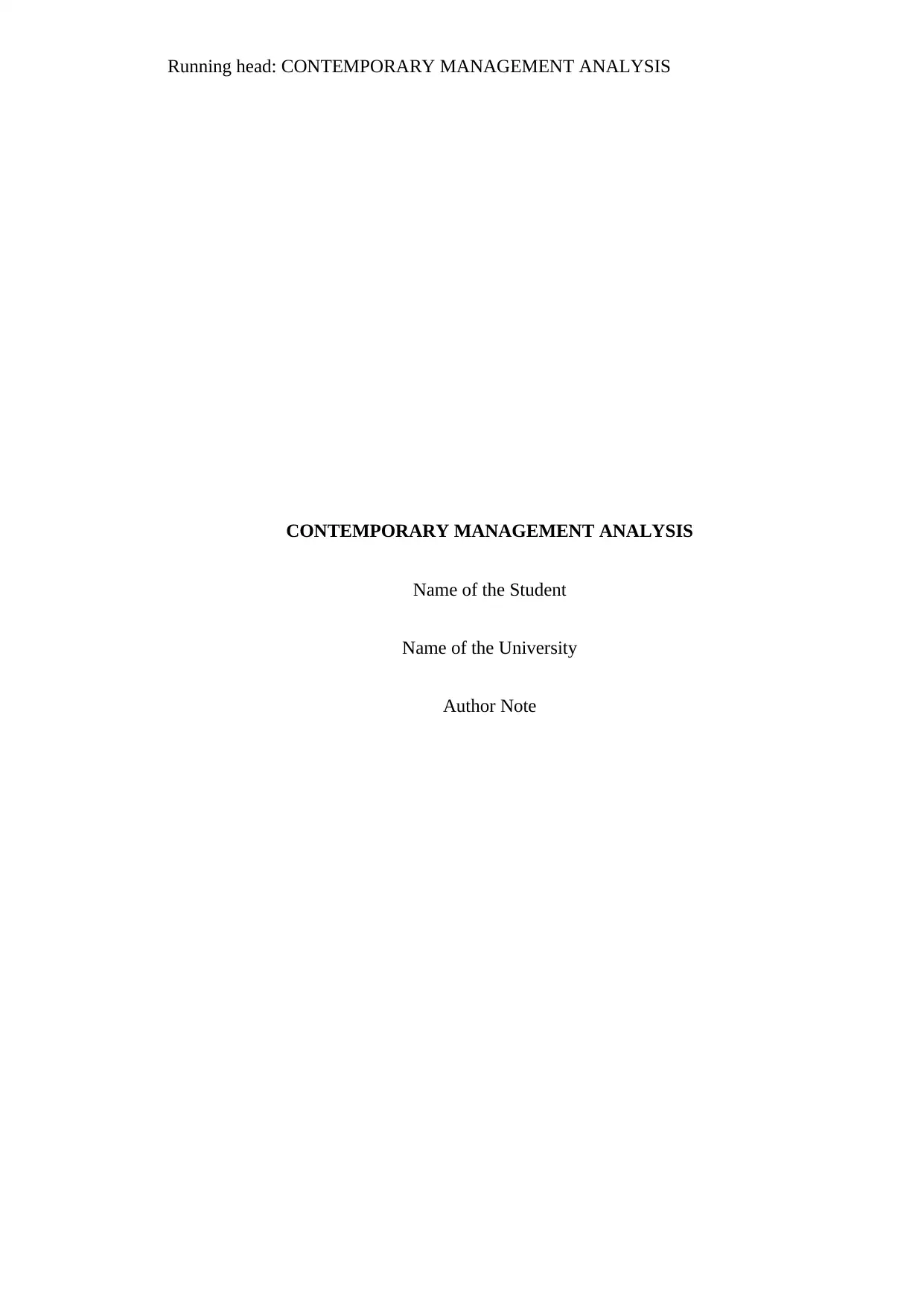
Running head: CONTEMPORARY MANAGEMENT ANALYSIS
CONTEMPORARY MANAGEMENT ANALYSIS
Name of the Student
Name of the University
Author Note
CONTEMPORARY MANAGEMENT ANALYSIS
Name of the Student
Name of the University
Author Note
Paraphrase This Document
Need a fresh take? Get an instant paraphrase of this document with our AI Paraphraser
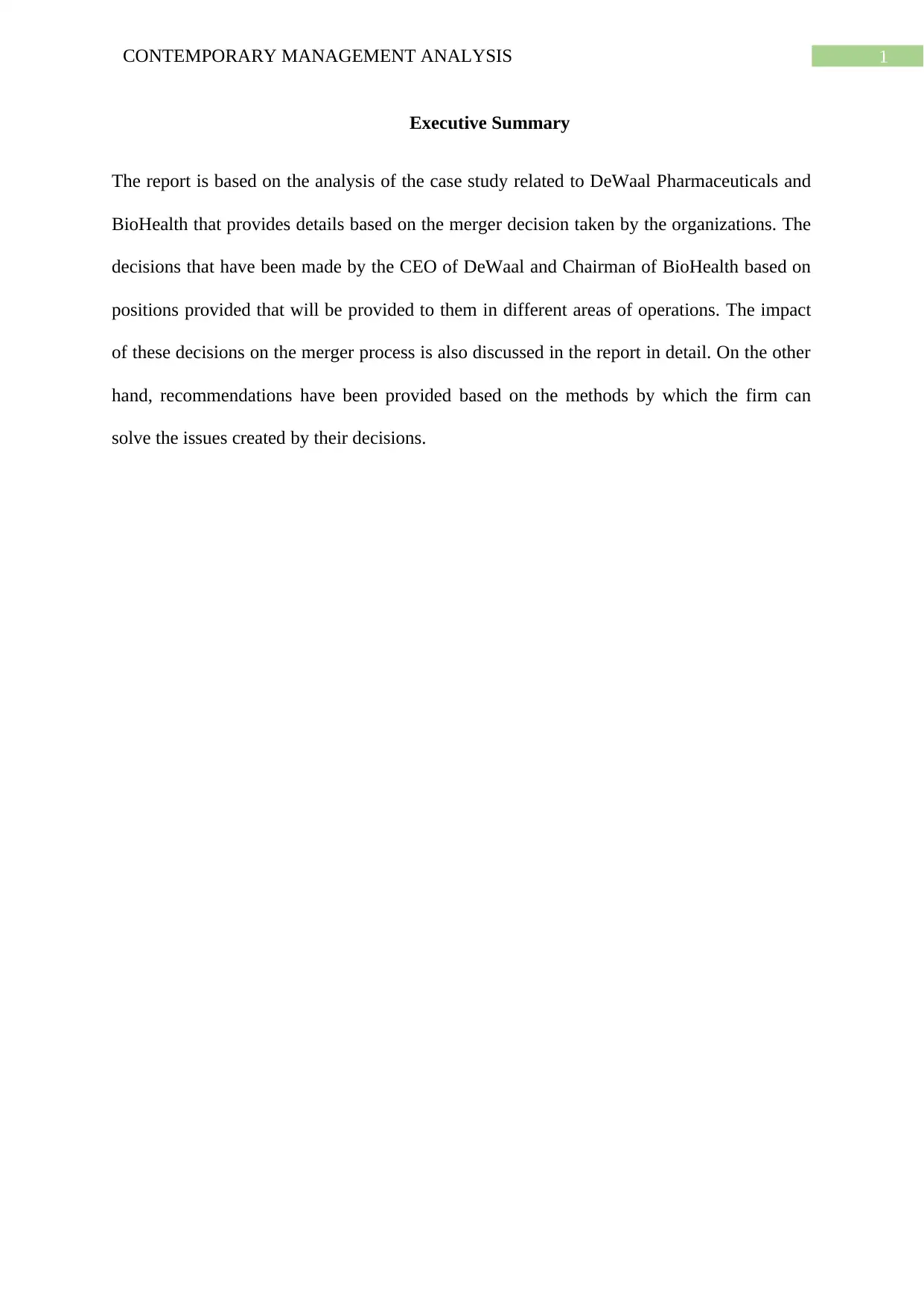
1CONTEMPORARY MANAGEMENT ANALYSIS
Executive Summary
The report is based on the analysis of the case study related to DeWaal Pharmaceuticals and
BioHealth that provides details based on the merger decision taken by the organizations. The
decisions that have been made by the CEO of DeWaal and Chairman of BioHealth based on
positions provided that will be provided to them in different areas of operations. The impact
of these decisions on the merger process is also discussed in the report in detail. On the other
hand, recommendations have been provided based on the methods by which the firm can
solve the issues created by their decisions.
Executive Summary
The report is based on the analysis of the case study related to DeWaal Pharmaceuticals and
BioHealth that provides details based on the merger decision taken by the organizations. The
decisions that have been made by the CEO of DeWaal and Chairman of BioHealth based on
positions provided that will be provided to them in different areas of operations. The impact
of these decisions on the merger process is also discussed in the report in detail. On the other
hand, recommendations have been provided based on the methods by which the firm can
solve the issues created by their decisions.
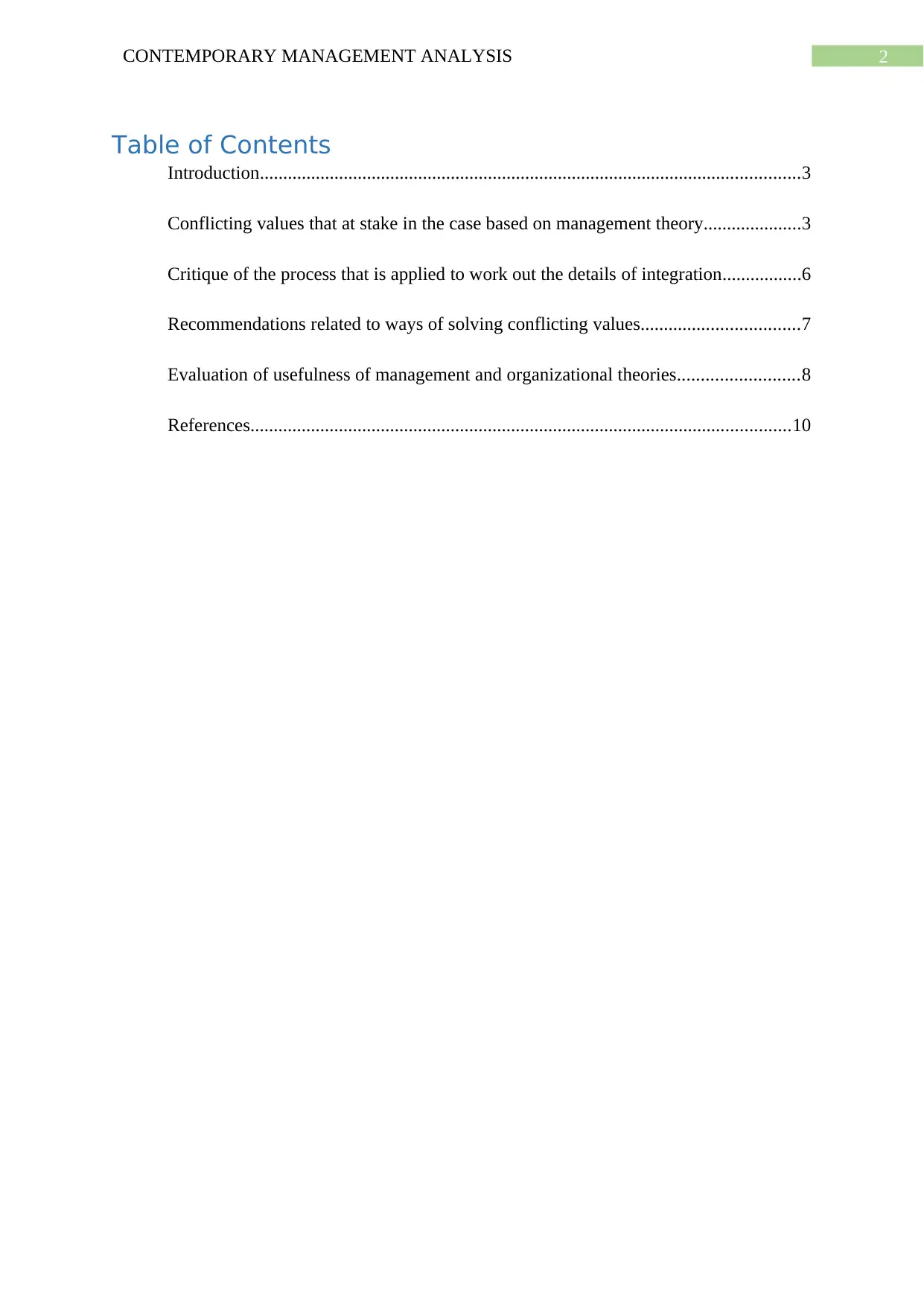
2CONTEMPORARY MANAGEMENT ANALYSIS
Table of Contents
Introduction....................................................................................................................3
Conflicting values that at stake in the case based on management theory.....................3
Critique of the process that is applied to work out the details of integration.................6
Recommendations related to ways of solving conflicting values..................................7
Evaluation of usefulness of management and organizational theories..........................8
References....................................................................................................................10
Table of Contents
Introduction....................................................................................................................3
Conflicting values that at stake in the case based on management theory.....................3
Critique of the process that is applied to work out the details of integration.................6
Recommendations related to ways of solving conflicting values..................................7
Evaluation of usefulness of management and organizational theories..........................8
References....................................................................................................................10
⊘ This is a preview!⊘
Do you want full access?
Subscribe today to unlock all pages.

Trusted by 1+ million students worldwide
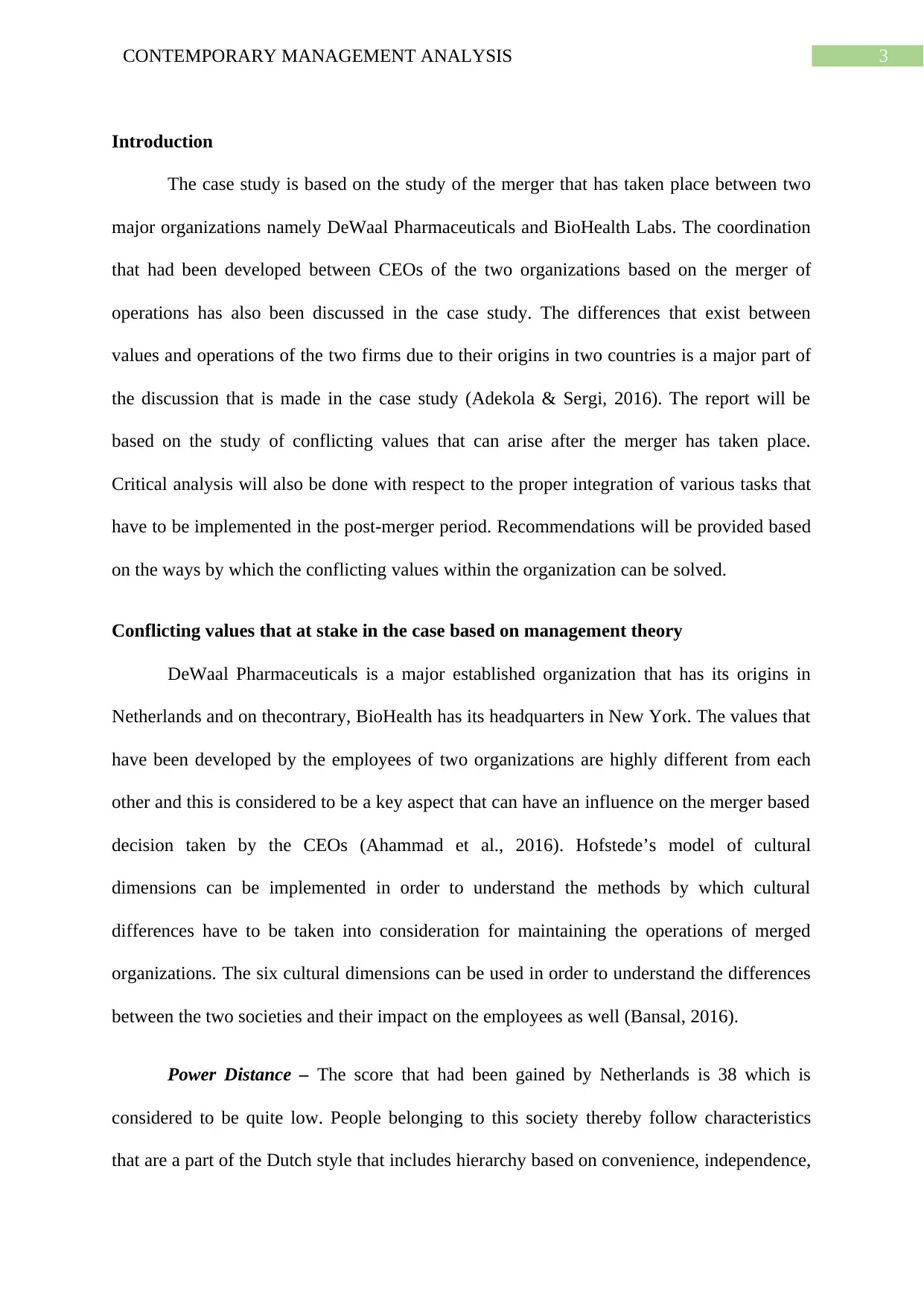
3CONTEMPORARY MANAGEMENT ANALYSIS
Introduction
The case study is based on the study of the merger that has taken place between two
major organizations namely DeWaal Pharmaceuticals and BioHealth Labs. The coordination
that had been developed between CEOs of the two organizations based on the merger of
operations has also been discussed in the case study. The differences that exist between
values and operations of the two firms due to their origins in two countries is a major part of
the discussion that is made in the case study (Adekola & Sergi, 2016). The report will be
based on the study of conflicting values that can arise after the merger has taken place.
Critical analysis will also be done with respect to the proper integration of various tasks that
have to be implemented in the post-merger period. Recommendations will be provided based
on the ways by which the conflicting values within the organization can be solved.
Conflicting values that at stake in the case based on management theory
DeWaal Pharmaceuticals is a major established organization that has its origins in
Netherlands and on thecontrary, BioHealth has its headquarters in New York. The values that
have been developed by the employees of two organizations are highly different from each
other and this is considered to be a key aspect that can have an influence on the merger based
decision taken by the CEOs (Ahammad et al., 2016). Hofstede’s model of cultural
dimensions can be implemented in order to understand the methods by which cultural
differences have to be taken into consideration for maintaining the operations of merged
organizations. The six cultural dimensions can be used in order to understand the differences
between the two societies and their impact on the employees as well (Bansal, 2016).
Power Distance – The score that had been gained by Netherlands is 38 which is
considered to be quite low. People belonging to this society thereby follow characteristics
that are a part of the Dutch style that includes hierarchy based on convenience, independence,
Introduction
The case study is based on the study of the merger that has taken place between two
major organizations namely DeWaal Pharmaceuticals and BioHealth Labs. The coordination
that had been developed between CEOs of the two organizations based on the merger of
operations has also been discussed in the case study. The differences that exist between
values and operations of the two firms due to their origins in two countries is a major part of
the discussion that is made in the case study (Adekola & Sergi, 2016). The report will be
based on the study of conflicting values that can arise after the merger has taken place.
Critical analysis will also be done with respect to the proper integration of various tasks that
have to be implemented in the post-merger period. Recommendations will be provided based
on the ways by which the conflicting values within the organization can be solved.
Conflicting values that at stake in the case based on management theory
DeWaal Pharmaceuticals is a major established organization that has its origins in
Netherlands and on thecontrary, BioHealth has its headquarters in New York. The values that
have been developed by the employees of two organizations are highly different from each
other and this is considered to be a key aspect that can have an influence on the merger based
decision taken by the CEOs (Ahammad et al., 2016). Hofstede’s model of cultural
dimensions can be implemented in order to understand the methods by which cultural
differences have to be taken into consideration for maintaining the operations of merged
organizations. The six cultural dimensions can be used in order to understand the differences
between the two societies and their impact on the employees as well (Bansal, 2016).
Power Distance – The score that had been gained by Netherlands is 38 which is
considered to be quite low. People belonging to this society thereby follow characteristics
that are a part of the Dutch style that includes hierarchy based on convenience, independence,
Paraphrase This Document
Need a fresh take? Get an instant paraphrase of this document with our AI Paraphraser
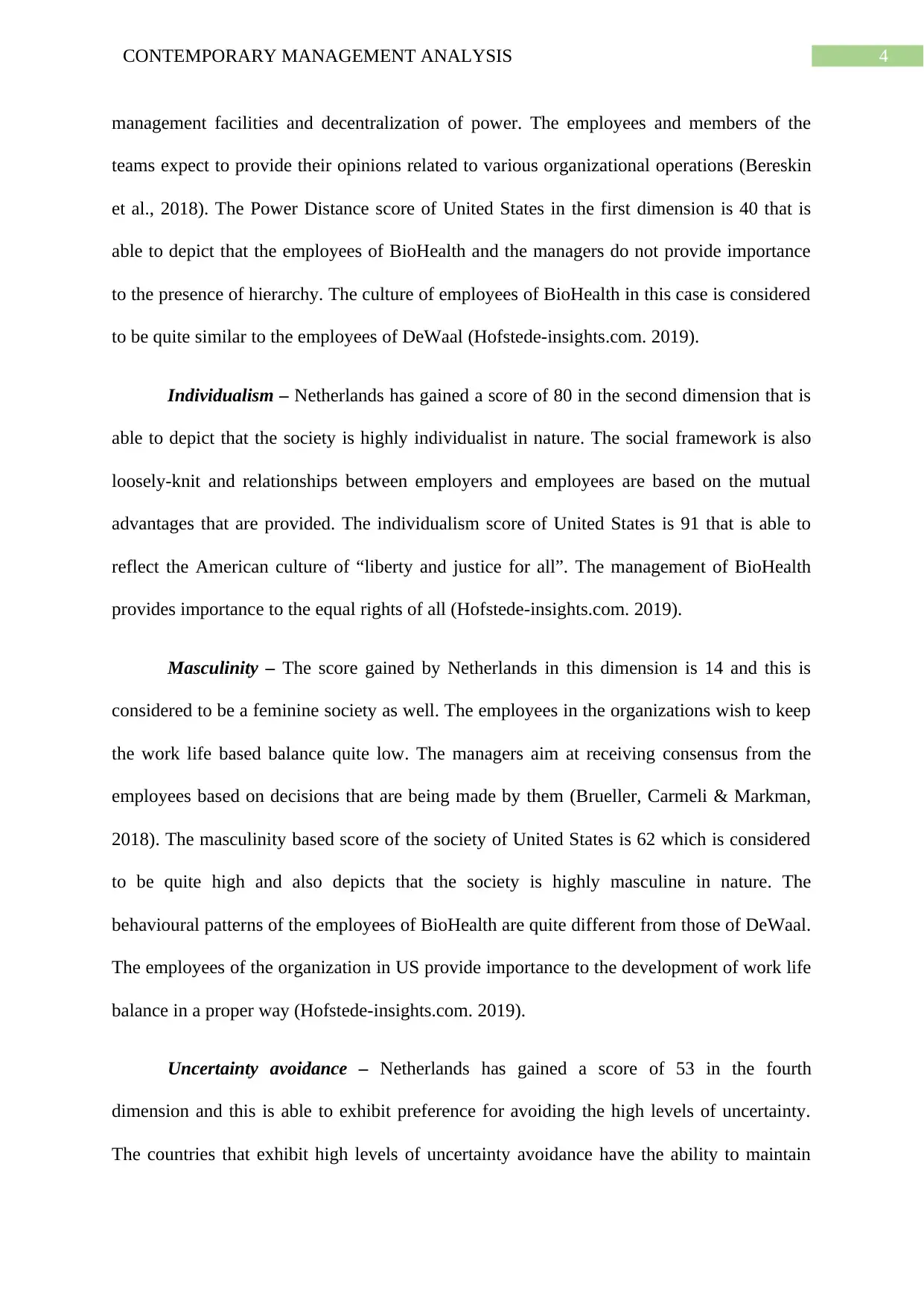
4CONTEMPORARY MANAGEMENT ANALYSIS
management facilities and decentralization of power. The employees and members of the
teams expect to provide their opinions related to various organizational operations (Bereskin
et al., 2018). The Power Distance score of United States in the first dimension is 40 that is
able to depict that the employees of BioHealth and the managers do not provide importance
to the presence of hierarchy. The culture of employees of BioHealth in this case is considered
to be quite similar to the employees of DeWaal (Hofstede-insights.com. 2019).
Individualism – Netherlands has gained a score of 80 in the second dimension that is
able to depict that the society is highly individualist in nature. The social framework is also
loosely-knit and relationships between employers and employees are based on the mutual
advantages that are provided. The individualism score of United States is 91 that is able to
reflect the American culture of “liberty and justice for all”. The management of BioHealth
provides importance to the equal rights of all (Hofstede-insights.com. 2019).
Masculinity – The score gained by Netherlands in this dimension is 14 and this is
considered to be a feminine society as well. The employees in the organizations wish to keep
the work life based balance quite low. The managers aim at receiving consensus from the
employees based on decisions that are being made by them (Brueller, Carmeli & Markman,
2018). The masculinity based score of the society of United States is 62 which is considered
to be quite high and also depicts that the society is highly masculine in nature. The
behavioural patterns of the employees of BioHealth are quite different from those of DeWaal.
The employees of the organization in US provide importance to the development of work life
balance in a proper way (Hofstede-insights.com. 2019).
Uncertainty avoidance – Netherlands has gained a score of 53 in the fourth
dimension and this is able to exhibit preference for avoiding the high levels of uncertainty.
The countries that exhibit high levels of uncertainty avoidance have the ability to maintain
management facilities and decentralization of power. The employees and members of the
teams expect to provide their opinions related to various organizational operations (Bereskin
et al., 2018). The Power Distance score of United States in the first dimension is 40 that is
able to depict that the employees of BioHealth and the managers do not provide importance
to the presence of hierarchy. The culture of employees of BioHealth in this case is considered
to be quite similar to the employees of DeWaal (Hofstede-insights.com. 2019).
Individualism – Netherlands has gained a score of 80 in the second dimension that is
able to depict that the society is highly individualist in nature. The social framework is also
loosely-knit and relationships between employers and employees are based on the mutual
advantages that are provided. The individualism score of United States is 91 that is able to
reflect the American culture of “liberty and justice for all”. The management of BioHealth
provides importance to the equal rights of all (Hofstede-insights.com. 2019).
Masculinity – The score gained by Netherlands in this dimension is 14 and this is
considered to be a feminine society as well. The employees in the organizations wish to keep
the work life based balance quite low. The managers aim at receiving consensus from the
employees based on decisions that are being made by them (Brueller, Carmeli & Markman,
2018). The masculinity based score of the society of United States is 62 which is considered
to be quite high and also depicts that the society is highly masculine in nature. The
behavioural patterns of the employees of BioHealth are quite different from those of DeWaal.
The employees of the organization in US provide importance to the development of work life
balance in a proper way (Hofstede-insights.com. 2019).
Uncertainty avoidance – Netherlands has gained a score of 53 in the fourth
dimension and this is able to exhibit preference for avoiding the high levels of uncertainty.
The countries that exhibit high levels of uncertainty avoidance have the ability to maintain
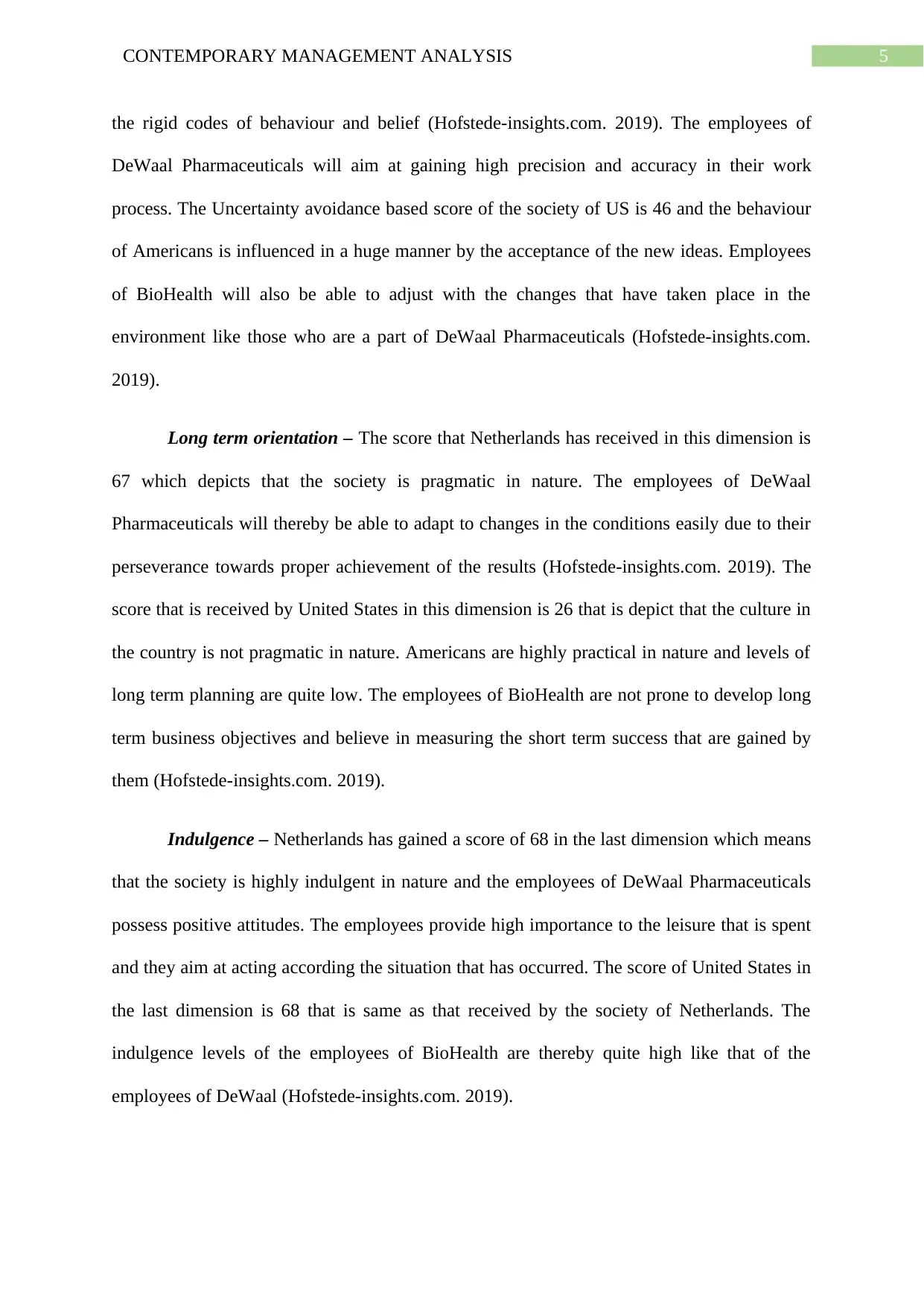
5CONTEMPORARY MANAGEMENT ANALYSIS
the rigid codes of behaviour and belief (Hofstede-insights.com. 2019). The employees of
DeWaal Pharmaceuticals will aim at gaining high precision and accuracy in their work
process. The Uncertainty avoidance based score of the society of US is 46 and the behaviour
of Americans is influenced in a huge manner by the acceptance of the new ideas. Employees
of BioHealth will also be able to adjust with the changes that have taken place in the
environment like those who are a part of DeWaal Pharmaceuticals (Hofstede-insights.com.
2019).
Long term orientation – The score that Netherlands has received in this dimension is
67 which depicts that the society is pragmatic in nature. The employees of DeWaal
Pharmaceuticals will thereby be able to adapt to changes in the conditions easily due to their
perseverance towards proper achievement of the results (Hofstede-insights.com. 2019). The
score that is received by United States in this dimension is 26 that is depict that the culture in
the country is not pragmatic in nature. Americans are highly practical in nature and levels of
long term planning are quite low. The employees of BioHealth are not prone to develop long
term business objectives and believe in measuring the short term success that are gained by
them (Hofstede-insights.com. 2019).
Indulgence – Netherlands has gained a score of 68 in the last dimension which means
that the society is highly indulgent in nature and the employees of DeWaal Pharmaceuticals
possess positive attitudes. The employees provide high importance to the leisure that is spent
and they aim at acting according the situation that has occurred. The score of United States in
the last dimension is 68 that is same as that received by the society of Netherlands. The
indulgence levels of the employees of BioHealth are thereby quite high like that of the
employees of DeWaal (Hofstede-insights.com. 2019).
the rigid codes of behaviour and belief (Hofstede-insights.com. 2019). The employees of
DeWaal Pharmaceuticals will aim at gaining high precision and accuracy in their work
process. The Uncertainty avoidance based score of the society of US is 46 and the behaviour
of Americans is influenced in a huge manner by the acceptance of the new ideas. Employees
of BioHealth will also be able to adjust with the changes that have taken place in the
environment like those who are a part of DeWaal Pharmaceuticals (Hofstede-insights.com.
2019).
Long term orientation – The score that Netherlands has received in this dimension is
67 which depicts that the society is pragmatic in nature. The employees of DeWaal
Pharmaceuticals will thereby be able to adapt to changes in the conditions easily due to their
perseverance towards proper achievement of the results (Hofstede-insights.com. 2019). The
score that is received by United States in this dimension is 26 that is depict that the culture in
the country is not pragmatic in nature. Americans are highly practical in nature and levels of
long term planning are quite low. The employees of BioHealth are not prone to develop long
term business objectives and believe in measuring the short term success that are gained by
them (Hofstede-insights.com. 2019).
Indulgence – Netherlands has gained a score of 68 in the last dimension which means
that the society is highly indulgent in nature and the employees of DeWaal Pharmaceuticals
possess positive attitudes. The employees provide high importance to the leisure that is spent
and they aim at acting according the situation that has occurred. The score of United States in
the last dimension is 68 that is same as that received by the society of Netherlands. The
indulgence levels of the employees of BioHealth are thereby quite high like that of the
employees of DeWaal (Hofstede-insights.com. 2019).
⊘ This is a preview!⊘
Do you want full access?
Subscribe today to unlock all pages.

Trusted by 1+ million students worldwide
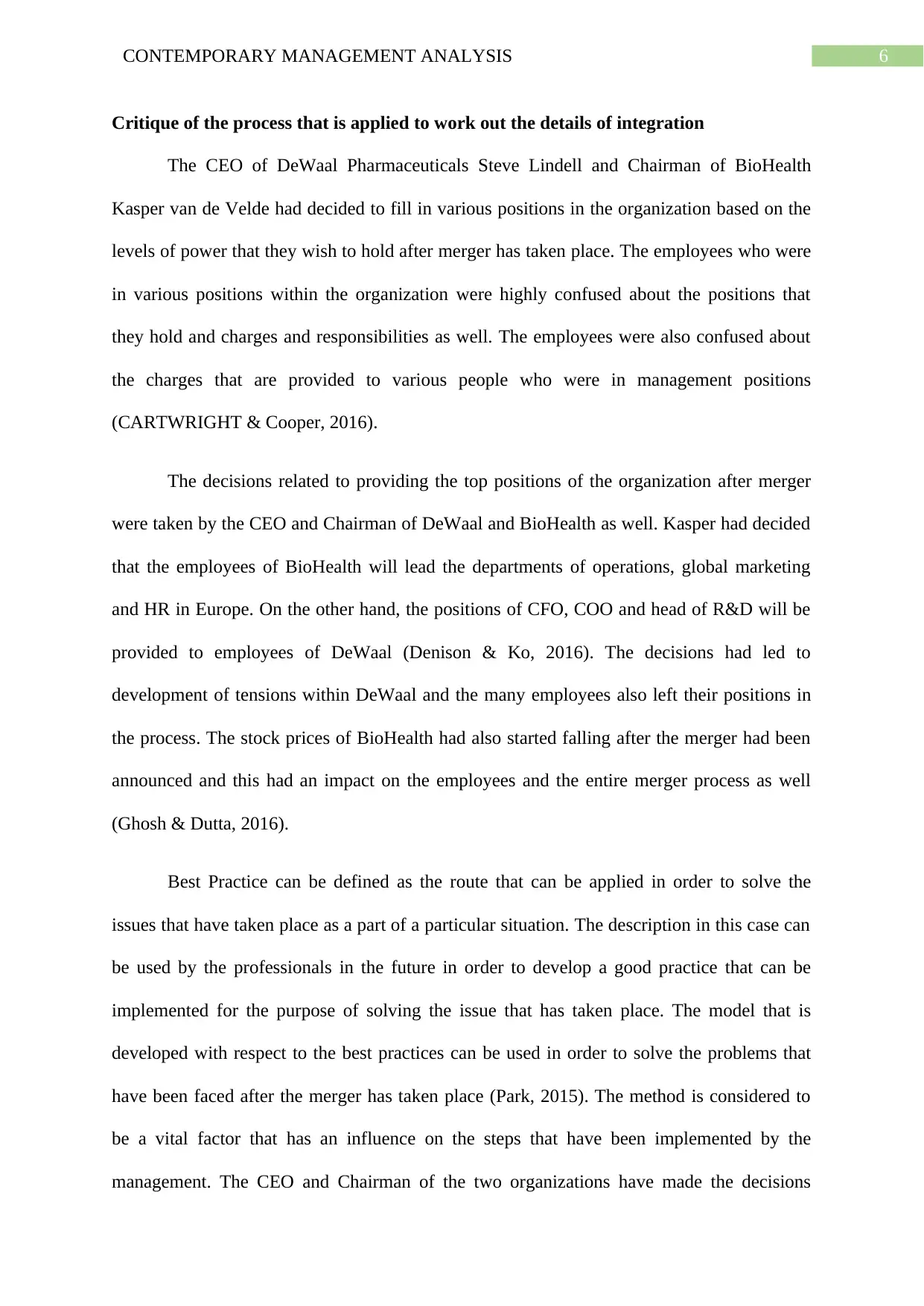
6CONTEMPORARY MANAGEMENT ANALYSIS
Critique of the process that is applied to work out the details of integration
The CEO of DeWaal Pharmaceuticals Steve Lindell and Chairman of BioHealth
Kasper van de Velde had decided to fill in various positions in the organization based on the
levels of power that they wish to hold after merger has taken place. The employees who were
in various positions within the organization were highly confused about the positions that
they hold and charges and responsibilities as well. The employees were also confused about
the charges that are provided to various people who were in management positions
(CARTWRIGHT & Cooper, 2016).
The decisions related to providing the top positions of the organization after merger
were taken by the CEO and Chairman of DeWaal and BioHealth as well. Kasper had decided
that the employees of BioHealth will lead the departments of operations, global marketing
and HR in Europe. On the other hand, the positions of CFO, COO and head of R&D will be
provided to employees of DeWaal (Denison & Ko, 2016). The decisions had led to
development of tensions within DeWaal and the many employees also left their positions in
the process. The stock prices of BioHealth had also started falling after the merger had been
announced and this had an impact on the employees and the entire merger process as well
(Ghosh & Dutta, 2016).
Best Practice can be defined as the route that can be applied in order to solve the
issues that have taken place as a part of a particular situation. The description in this case can
be used by the professionals in the future in order to develop a good practice that can be
implemented for the purpose of solving the issue that has taken place. The model that is
developed with respect to the best practices can be used in order to solve the problems that
have been faced after the merger has taken place (Park, 2015). The method is considered to
be a vital factor that has an influence on the steps that have been implemented by the
management. The CEO and Chairman of the two organizations have made the decisions
Critique of the process that is applied to work out the details of integration
The CEO of DeWaal Pharmaceuticals Steve Lindell and Chairman of BioHealth
Kasper van de Velde had decided to fill in various positions in the organization based on the
levels of power that they wish to hold after merger has taken place. The employees who were
in various positions within the organization were highly confused about the positions that
they hold and charges and responsibilities as well. The employees were also confused about
the charges that are provided to various people who were in management positions
(CARTWRIGHT & Cooper, 2016).
The decisions related to providing the top positions of the organization after merger
were taken by the CEO and Chairman of DeWaal and BioHealth as well. Kasper had decided
that the employees of BioHealth will lead the departments of operations, global marketing
and HR in Europe. On the other hand, the positions of CFO, COO and head of R&D will be
provided to employees of DeWaal (Denison & Ko, 2016). The decisions had led to
development of tensions within DeWaal and the many employees also left their positions in
the process. The stock prices of BioHealth had also started falling after the merger had been
announced and this had an impact on the employees and the entire merger process as well
(Ghosh & Dutta, 2016).
Best Practice can be defined as the route that can be applied in order to solve the
issues that have taken place as a part of a particular situation. The description in this case can
be used by the professionals in the future in order to develop a good practice that can be
implemented for the purpose of solving the issue that has taken place. The model that is
developed with respect to the best practices can be used in order to solve the problems that
have been faced after the merger has taken place (Park, 2015). The method is considered to
be a vital factor that has an influence on the steps that have been implemented by the
management. The CEO and Chairman of the two organizations have made the decisions
Paraphrase This Document
Need a fresh take? Get an instant paraphrase of this document with our AI Paraphraser
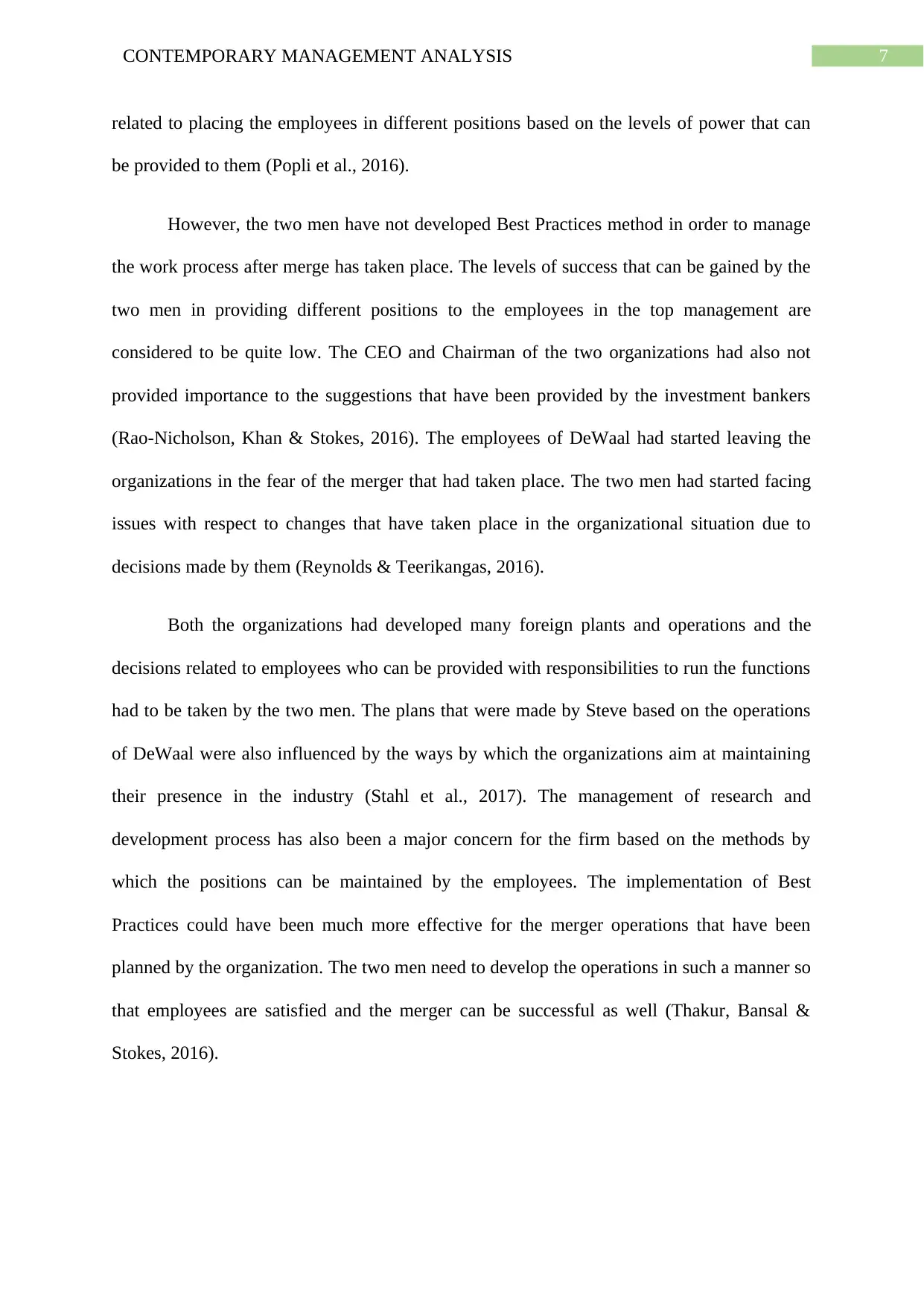
7CONTEMPORARY MANAGEMENT ANALYSIS
related to placing the employees in different positions based on the levels of power that can
be provided to them (Popli et al., 2016).
However, the two men have not developed Best Practices method in order to manage
the work process after merge has taken place. The levels of success that can be gained by the
two men in providing different positions to the employees in the top management are
considered to be quite low. The CEO and Chairman of the two organizations had also not
provided importance to the suggestions that have been provided by the investment bankers
(Rao-Nicholson, Khan & Stokes, 2016). The employees of DeWaal had started leaving the
organizations in the fear of the merger that had taken place. The two men had started facing
issues with respect to changes that have taken place in the organizational situation due to
decisions made by them (Reynolds & Teerikangas, 2016).
Both the organizations had developed many foreign plants and operations and the
decisions related to employees who can be provided with responsibilities to run the functions
had to be taken by the two men. The plans that were made by Steve based on the operations
of DeWaal were also influenced by the ways by which the organizations aim at maintaining
their presence in the industry (Stahl et al., 2017). The management of research and
development process has also been a major concern for the firm based on the methods by
which the positions can be maintained by the employees. The implementation of Best
Practices could have been much more effective for the merger operations that have been
planned by the organization. The two men need to develop the operations in such a manner so
that employees are satisfied and the merger can be successful as well (Thakur, Bansal &
Stokes, 2016).
related to placing the employees in different positions based on the levels of power that can
be provided to them (Popli et al., 2016).
However, the two men have not developed Best Practices method in order to manage
the work process after merge has taken place. The levels of success that can be gained by the
two men in providing different positions to the employees in the top management are
considered to be quite low. The CEO and Chairman of the two organizations had also not
provided importance to the suggestions that have been provided by the investment bankers
(Rao-Nicholson, Khan & Stokes, 2016). The employees of DeWaal had started leaving the
organizations in the fear of the merger that had taken place. The two men had started facing
issues with respect to changes that have taken place in the organizational situation due to
decisions made by them (Reynolds & Teerikangas, 2016).
Both the organizations had developed many foreign plants and operations and the
decisions related to employees who can be provided with responsibilities to run the functions
had to be taken by the two men. The plans that were made by Steve based on the operations
of DeWaal were also influenced by the ways by which the organizations aim at maintaining
their presence in the industry (Stahl et al., 2017). The management of research and
development process has also been a major concern for the firm based on the methods by
which the positions can be maintained by the employees. The implementation of Best
Practices could have been much more effective for the merger operations that have been
planned by the organization. The two men need to develop the operations in such a manner so
that employees are satisfied and the merger can be successful as well (Thakur, Bansal &
Stokes, 2016).
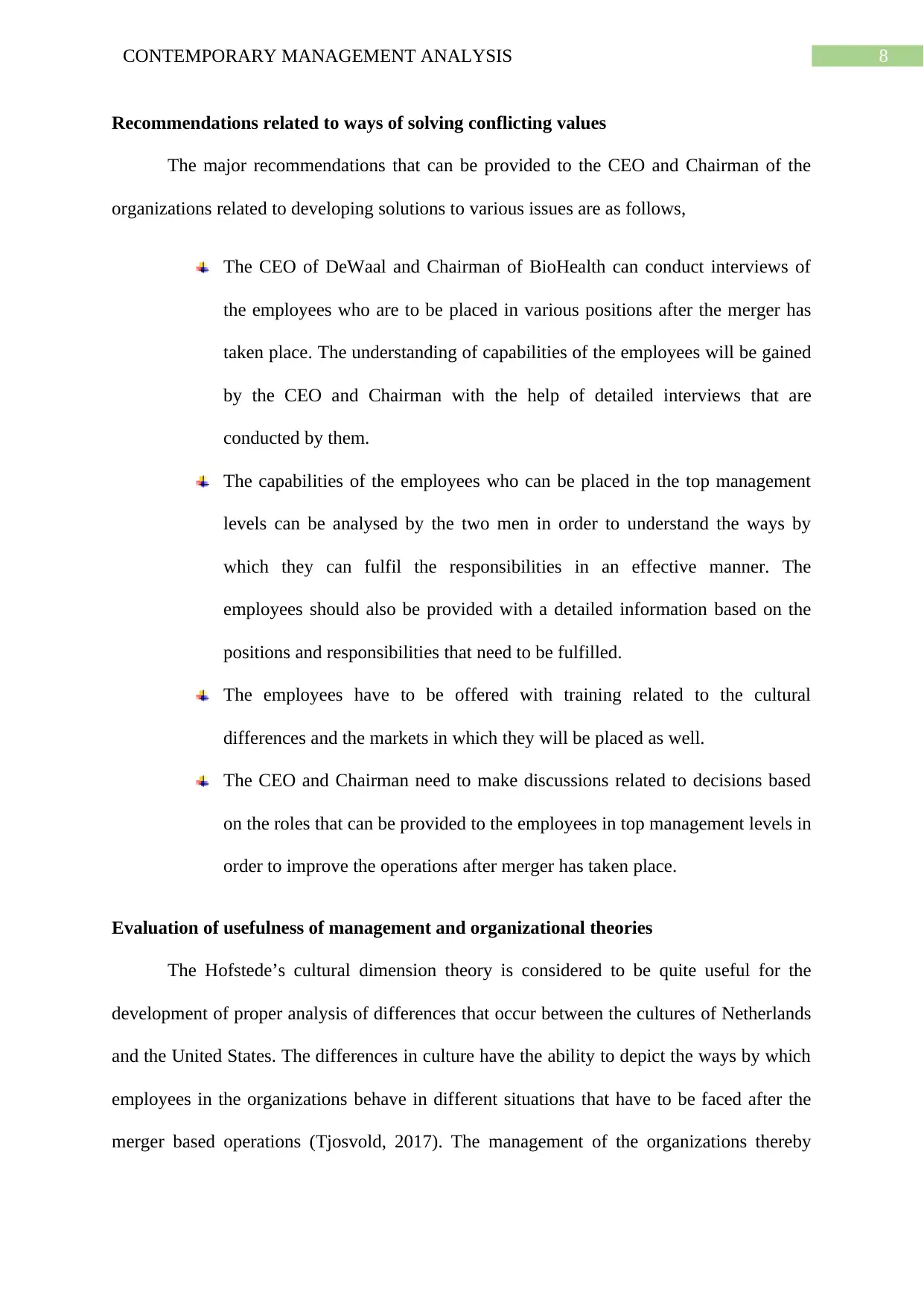
8CONTEMPORARY MANAGEMENT ANALYSIS
Recommendations related to ways of solving conflicting values
The major recommendations that can be provided to the CEO and Chairman of the
organizations related to developing solutions to various issues are as follows,
The CEO of DeWaal and Chairman of BioHealth can conduct interviews of
the employees who are to be placed in various positions after the merger has
taken place. The understanding of capabilities of the employees will be gained
by the CEO and Chairman with the help of detailed interviews that are
conducted by them.
The capabilities of the employees who can be placed in the top management
levels can be analysed by the two men in order to understand the ways by
which they can fulfil the responsibilities in an effective manner. The
employees should also be provided with a detailed information based on the
positions and responsibilities that need to be fulfilled.
The employees have to be offered with training related to the cultural
differences and the markets in which they will be placed as well.
The CEO and Chairman need to make discussions related to decisions based
on the roles that can be provided to the employees in top management levels in
order to improve the operations after merger has taken place.
Evaluation of usefulness of management and organizational theories
The Hofstede’s cultural dimension theory is considered to be quite useful for the
development of proper analysis of differences that occur between the cultures of Netherlands
and the United States. The differences in culture have the ability to depict the ways by which
employees in the organizations behave in different situations that have to be faced after the
merger based operations (Tjosvold, 2017). The management of the organizations thereby
Recommendations related to ways of solving conflicting values
The major recommendations that can be provided to the CEO and Chairman of the
organizations related to developing solutions to various issues are as follows,
The CEO of DeWaal and Chairman of BioHealth can conduct interviews of
the employees who are to be placed in various positions after the merger has
taken place. The understanding of capabilities of the employees will be gained
by the CEO and Chairman with the help of detailed interviews that are
conducted by them.
The capabilities of the employees who can be placed in the top management
levels can be analysed by the two men in order to understand the ways by
which they can fulfil the responsibilities in an effective manner. The
employees should also be provided with a detailed information based on the
positions and responsibilities that need to be fulfilled.
The employees have to be offered with training related to the cultural
differences and the markets in which they will be placed as well.
The CEO and Chairman need to make discussions related to decisions based
on the roles that can be provided to the employees in top management levels in
order to improve the operations after merger has taken place.
Evaluation of usefulness of management and organizational theories
The Hofstede’s cultural dimension theory is considered to be quite useful for the
development of proper analysis of differences that occur between the cultures of Netherlands
and the United States. The differences in culture have the ability to depict the ways by which
employees in the organizations behave in different situations that have to be faced after the
merger based operations (Tjosvold, 2017). The management of the organizations thereby
⊘ This is a preview!⊘
Do you want full access?
Subscribe today to unlock all pages.

Trusted by 1+ million students worldwide
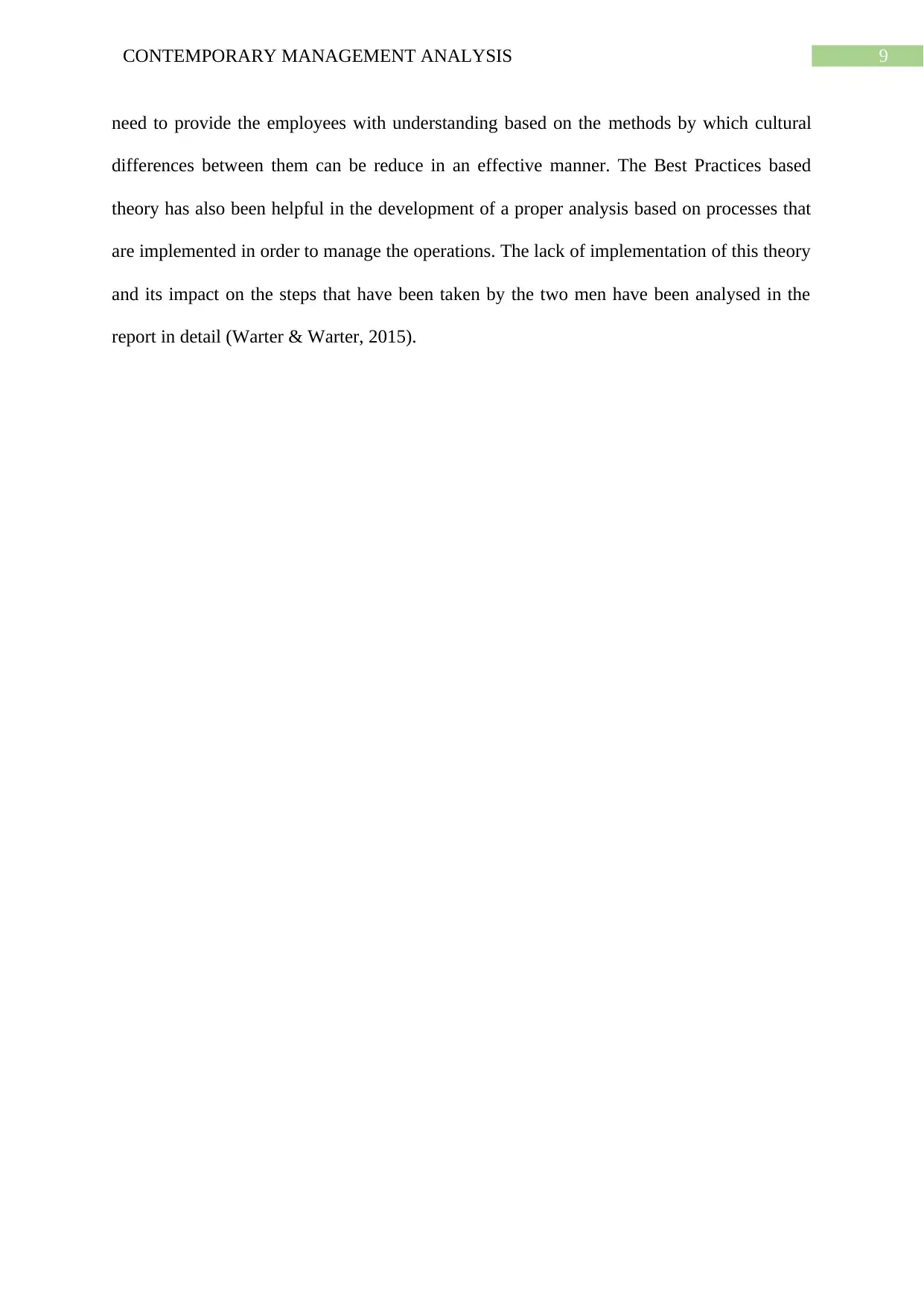
9CONTEMPORARY MANAGEMENT ANALYSIS
need to provide the employees with understanding based on the methods by which cultural
differences between them can be reduce in an effective manner. The Best Practices based
theory has also been helpful in the development of a proper analysis based on processes that
are implemented in order to manage the operations. The lack of implementation of this theory
and its impact on the steps that have been taken by the two men have been analysed in the
report in detail (Warter & Warter, 2015).
need to provide the employees with understanding based on the methods by which cultural
differences between them can be reduce in an effective manner. The Best Practices based
theory has also been helpful in the development of a proper analysis based on processes that
are implemented in order to manage the operations. The lack of implementation of this theory
and its impact on the steps that have been taken by the two men have been analysed in the
report in detail (Warter & Warter, 2015).
Paraphrase This Document
Need a fresh take? Get an instant paraphrase of this document with our AI Paraphraser
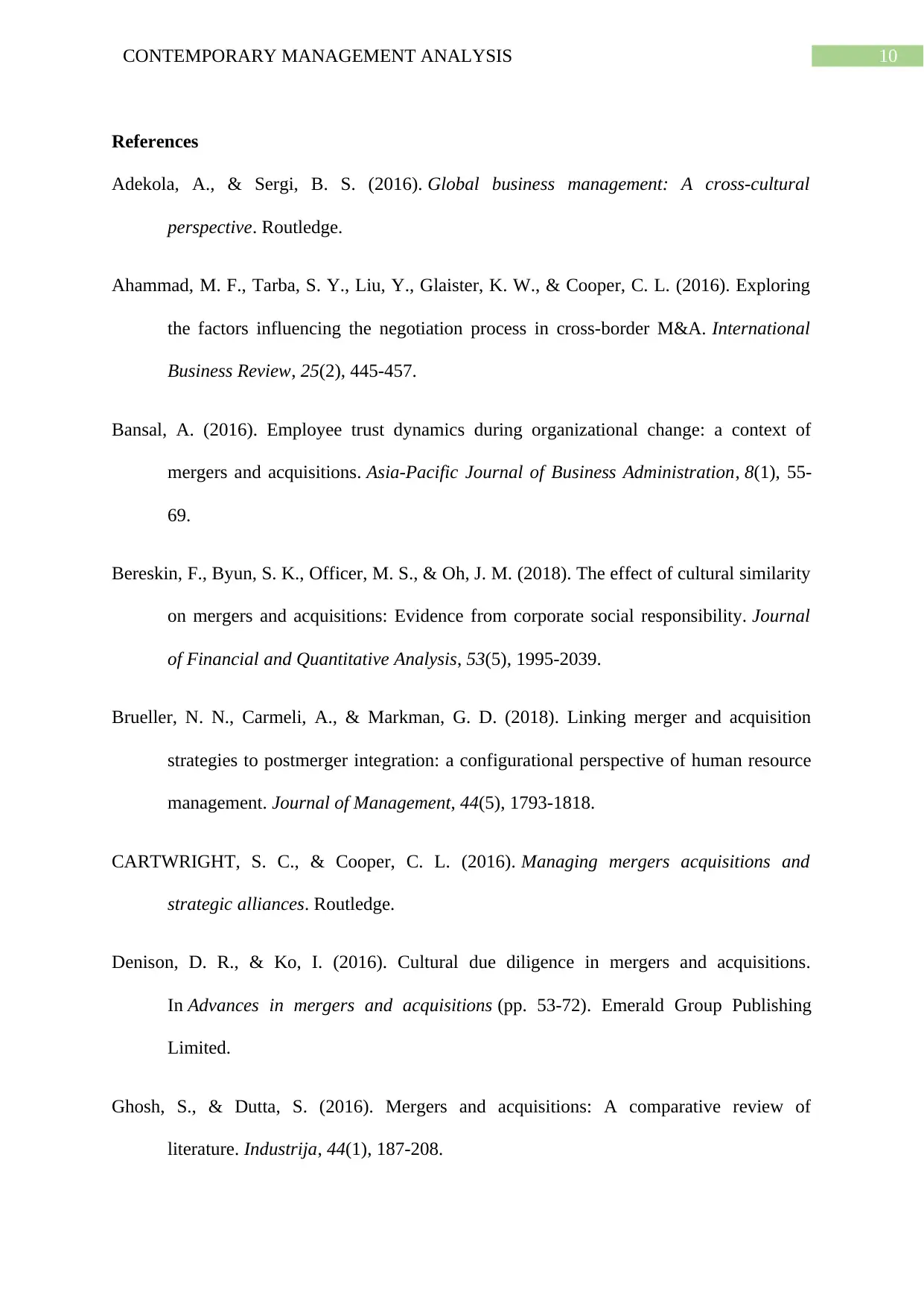
10CONTEMPORARY MANAGEMENT ANALYSIS
References
Adekola, A., & Sergi, B. S. (2016). Global business management: A cross-cultural
perspective. Routledge.
Ahammad, M. F., Tarba, S. Y., Liu, Y., Glaister, K. W., & Cooper, C. L. (2016). Exploring
the factors influencing the negotiation process in cross-border M&A. International
Business Review, 25(2), 445-457.
Bansal, A. (2016). Employee trust dynamics during organizational change: a context of
mergers and acquisitions. Asia-Pacific Journal of Business Administration, 8(1), 55-
69.
Bereskin, F., Byun, S. K., Officer, M. S., & Oh, J. M. (2018). The effect of cultural similarity
on mergers and acquisitions: Evidence from corporate social responsibility. Journal
of Financial and Quantitative Analysis, 53(5), 1995-2039.
Brueller, N. N., Carmeli, A., & Markman, G. D. (2018). Linking merger and acquisition
strategies to postmerger integration: a configurational perspective of human resource
management. Journal of Management, 44(5), 1793-1818.
CARTWRIGHT, S. C., & Cooper, C. L. (2016). Managing mergers acquisitions and
strategic alliances. Routledge.
Denison, D. R., & Ko, I. (2016). Cultural due diligence in mergers and acquisitions.
In Advances in mergers and acquisitions (pp. 53-72). Emerald Group Publishing
Limited.
Ghosh, S., & Dutta, S. (2016). Mergers and acquisitions: A comparative review of
literature. Industrija, 44(1), 187-208.
References
Adekola, A., & Sergi, B. S. (2016). Global business management: A cross-cultural
perspective. Routledge.
Ahammad, M. F., Tarba, S. Y., Liu, Y., Glaister, K. W., & Cooper, C. L. (2016). Exploring
the factors influencing the negotiation process in cross-border M&A. International
Business Review, 25(2), 445-457.
Bansal, A. (2016). Employee trust dynamics during organizational change: a context of
mergers and acquisitions. Asia-Pacific Journal of Business Administration, 8(1), 55-
69.
Bereskin, F., Byun, S. K., Officer, M. S., & Oh, J. M. (2018). The effect of cultural similarity
on mergers and acquisitions: Evidence from corporate social responsibility. Journal
of Financial and Quantitative Analysis, 53(5), 1995-2039.
Brueller, N. N., Carmeli, A., & Markman, G. D. (2018). Linking merger and acquisition
strategies to postmerger integration: a configurational perspective of human resource
management. Journal of Management, 44(5), 1793-1818.
CARTWRIGHT, S. C., & Cooper, C. L. (2016). Managing mergers acquisitions and
strategic alliances. Routledge.
Denison, D. R., & Ko, I. (2016). Cultural due diligence in mergers and acquisitions.
In Advances in mergers and acquisitions (pp. 53-72). Emerald Group Publishing
Limited.
Ghosh, S., & Dutta, S. (2016). Mergers and acquisitions: A comparative review of
literature. Industrija, 44(1), 187-208.
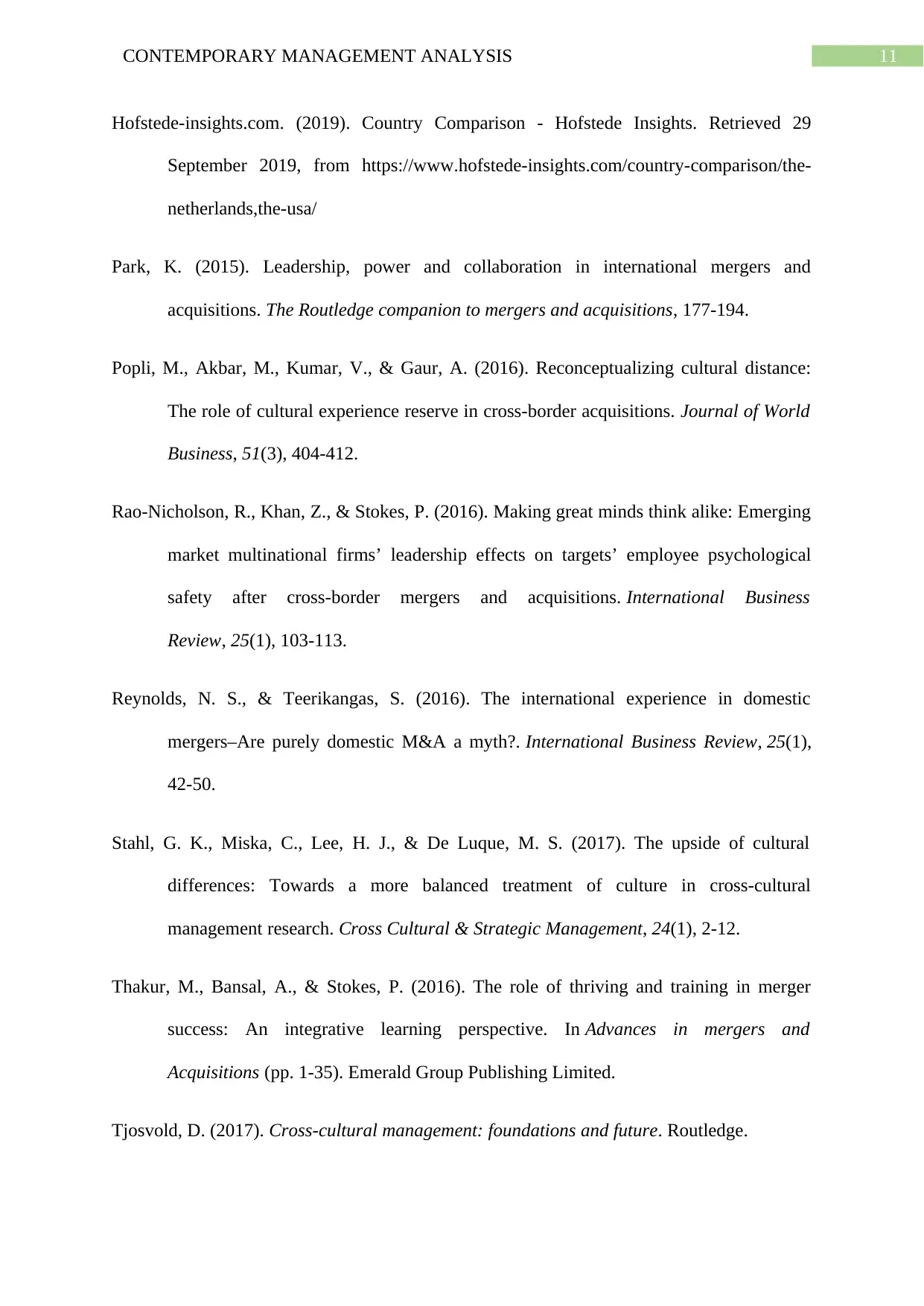
11CONTEMPORARY MANAGEMENT ANALYSIS
Hofstede-insights.com. (2019). Country Comparison - Hofstede Insights. Retrieved 29
September 2019, from https://www.hofstede-insights.com/country-comparison/the-
netherlands,the-usa/
Park, K. (2015). Leadership, power and collaboration in international mergers and
acquisitions. The Routledge companion to mergers and acquisitions, 177-194.
Popli, M., Akbar, M., Kumar, V., & Gaur, A. (2016). Reconceptualizing cultural distance:
The role of cultural experience reserve in cross-border acquisitions. Journal of World
Business, 51(3), 404-412.
Rao-Nicholson, R., Khan, Z., & Stokes, P. (2016). Making great minds think alike: Emerging
market multinational firms’ leadership effects on targets’ employee psychological
safety after cross-border mergers and acquisitions. International Business
Review, 25(1), 103-113.
Reynolds, N. S., & Teerikangas, S. (2016). The international experience in domestic
mergers–Are purely domestic M&A a myth?. International Business Review, 25(1),
42-50.
Stahl, G. K., Miska, C., Lee, H. J., & De Luque, M. S. (2017). The upside of cultural
differences: Towards a more balanced treatment of culture in cross-cultural
management research. Cross Cultural & Strategic Management, 24(1), 2-12.
Thakur, M., Bansal, A., & Stokes, P. (2016). The role of thriving and training in merger
success: An integrative learning perspective. In Advances in mergers and
Acquisitions (pp. 1-35). Emerald Group Publishing Limited.
Tjosvold, D. (2017). Cross-cultural management: foundations and future. Routledge.
Hofstede-insights.com. (2019). Country Comparison - Hofstede Insights. Retrieved 29
September 2019, from https://www.hofstede-insights.com/country-comparison/the-
netherlands,the-usa/
Park, K. (2015). Leadership, power and collaboration in international mergers and
acquisitions. The Routledge companion to mergers and acquisitions, 177-194.
Popli, M., Akbar, M., Kumar, V., & Gaur, A. (2016). Reconceptualizing cultural distance:
The role of cultural experience reserve in cross-border acquisitions. Journal of World
Business, 51(3), 404-412.
Rao-Nicholson, R., Khan, Z., & Stokes, P. (2016). Making great minds think alike: Emerging
market multinational firms’ leadership effects on targets’ employee psychological
safety after cross-border mergers and acquisitions. International Business
Review, 25(1), 103-113.
Reynolds, N. S., & Teerikangas, S. (2016). The international experience in domestic
mergers–Are purely domestic M&A a myth?. International Business Review, 25(1),
42-50.
Stahl, G. K., Miska, C., Lee, H. J., & De Luque, M. S. (2017). The upside of cultural
differences: Towards a more balanced treatment of culture in cross-cultural
management research. Cross Cultural & Strategic Management, 24(1), 2-12.
Thakur, M., Bansal, A., & Stokes, P. (2016). The role of thriving and training in merger
success: An integrative learning perspective. In Advances in mergers and
Acquisitions (pp. 1-35). Emerald Group Publishing Limited.
Tjosvold, D. (2017). Cross-cultural management: foundations and future. Routledge.
⊘ This is a preview!⊘
Do you want full access?
Subscribe today to unlock all pages.

Trusted by 1+ million students worldwide
1 out of 13
Related Documents
Your All-in-One AI-Powered Toolkit for Academic Success.
+13062052269
info@desklib.com
Available 24*7 on WhatsApp / Email
![[object Object]](/_next/static/media/star-bottom.7253800d.svg)
Unlock your academic potential
Copyright © 2020–2025 A2Z Services. All Rights Reserved. Developed and managed by ZUCOL.





